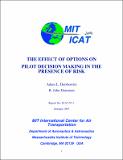The Effect Of Options On Pilot Decision Making In The Presence Of Risk
Author(s)
Dershowitz, Adam L.; Hansman, R. John
DownloadDershowitz.pdf (1.351Mb)
Metadata
Show full item recordAbstract
An Option-Based Decision Framework is developed. This Framework may be applied to decisions that must be made in the face of high risk. The work is motivated by the needs of decision makers, specifically aviation decision makers. A survey of pilots was completed and demonstrates that these decision makers feel that knowledge of which options are available is important to them when they are facing high risk situations. The Option-Based Decision Framework (OBDF) is developed and is applied to decision making and is used to define what is called “Decision Space” that may be used to make decisions and to understand the information needs of decision makers. Decision makers are not able to accurately assess small probabilities however it is assumed that they are able to assess hazard and option probabilities into general categories. This categorization is used to define decision guidance rules for decision makers. In order to demonstrate its use the OBDF is applied to an experiment. Finally the Framework is applied to some examples, and the implications of the Option-Based Decision Framework are discussed.
The Option-Based Decision Framework offers insight into the decision process. Although it is a static model, the general understanding may be applied to both static and dynamic decisions. The OBDF demonstrates how options have the effect of mitigating risk due to the presence of a Catastrophic End State. Thus, options maybe used to increase the safety to decision makers. The Framework may be used to understand the information needs of decision makers, to define procedures, to understand judgment, and to help train decision makers.
Date issued
97-10Publisher
International Center for Air Transportation
Series/Report no.
ICAT-97-1
Keywords
Option-Based Decision Framework, decision making, human factors, air transportation